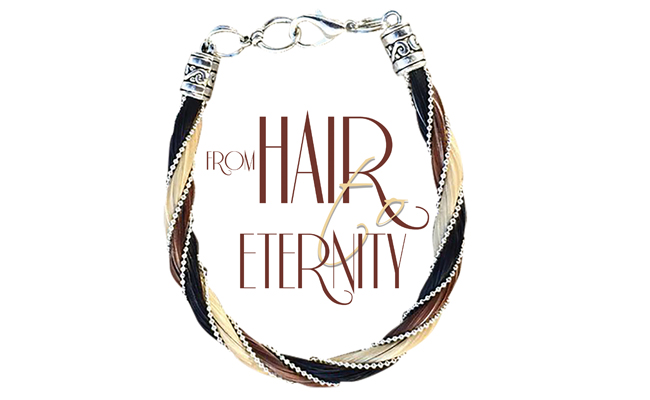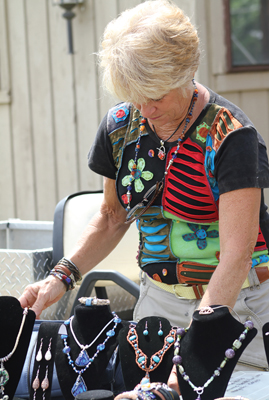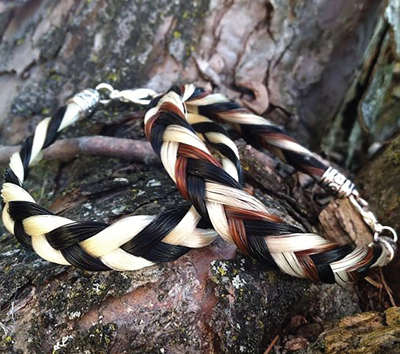Jewelry designers use strands of hair to help horse lovers create keepsakes to commemorate a lost friend or special accomplishment.
 Somewhere in a drawer in the house or on a shelf in the barn you likely have a bundle of hair saved from a cherished horse that you no longer own. Whether the hair was lovingly saved after the horse’s death or before the horse was sold, keeping that portion of hair preserves the special bond you shared. Designers as passionate about horses as the clients they serve offer hand-crafted keepsakes that brings the locks out of the shadows to honor the horse’s memory.
Somewhere in a drawer in the house or on a shelf in the barn you likely have a bundle of hair saved from a cherished horse that you no longer own. Whether the hair was lovingly saved after the horse’s death or before the horse was sold, keeping that portion of hair preserves the special bond you shared. Designers as passionate about horses as the clients they serve offer hand-crafted keepsakes that brings the locks out of the shadows to honor the horse’s memory.
Most often, the horse hair is cut after a horse’s death. Braiding horse hair into key chains, bracelets and other keepsakes enabled Pennsylvania artist Aimee Cain who started Equine Keepsakes to grieve the loss of her own horse, Pretty Boy who passed away unexpectedly. Before his death, she was unaware these items were popular. A friend suggested she make a horse hair bracelet because Cain was already a skilled crafter.
“That bracelet was all that I had left of my precious boy, and it meant more to me than words could ever explain,” she said. “I knew then that I wanted to begin designing horse hair jewelry, even if to just create one to honor my sweet boy.”
Horse hair accessories are nothing new to Lou Petty who has been involved with the horse industry for more than three decades. When she was showing in the 1980s she made her own horse hair pins for show shirts. Then when Carol Harris lost Rugged Lark in 2003, Petty offered to make a piece of jewelry for her. Harris and Petty are neighbors and close friends Harris encouraged her to do the same for others. Over the past 14 years she has found a significant demand for the items.
 “The biggest reward is when people are comforted by the piece I’ve created for them,” she said.
“The biggest reward is when people are comforted by the piece I’ve created for them,” she said.
Not every piece symbolizes a horse’s passing. Horse hair accessories are also worn daily to celebrate a special partnership with a horse or to keep a horse that is sold close to one’s heart. Petty wears bracelets made from the tail hair of A Certain Melody (Chloe) and Certain Beau Purple (Eddie) two foals by of her former stallion Certain Potential. Both were born on the farm and hold a special place in her heart.
“I have friends who have nice gold and diamond jewelry they never wear, but they wear their horse hair jewelry every day,” she added.
Through horse hair jewelry, Erica Avratin a Bridgewater, Massachusetts engineer by day and designer by night, has discovered the fulfillment of a business that satisfies customers and her own aspirations at the same time. In 2011, she faced significant life changes. She knew she needed to keep her horses to help her through those challenges. She also needed an additional
source of income to support the horses. Her horse hair jewelry business, The Horsehair Studio buoyed her spirits and enabled her to keep the horses.
“Creating something beautiful and meaningful for other people also helped me through a difficult time in my life,” she said. “It’s also rewarding to do something for others that they can’t do themselves.”
 How much hair is needed?
How much hair is needed?
The next time you cut a lock of hair, even if you don’t have current plans for a keepsake, remember that the more you keep, the easier it will be to have a memento created if you change your mind down the road. Smaller pieces like a ring or key chain won’t need as much as a necklace or bracelet, but saving an adequate amount allows for flexibility. Tail hair is more durable than the mane and preferred although mane hair can be used if necessary.
When clients have an opportunity to plan for a piece, Petty asks for 28 inches of tail hair about the width of a client’s little finger whereas Avratin works with hair that is pencil width in size. Double stranded items need two pencil widths. She prefers the hair is at least 15-16 inches long, but she admits she has worked with a lot less.
“Sometimes you have to get clever to make a little hair go a long way,” Avratin said. “The best hair is higher up in the tail because as it grows out it becomes thinner. When people send as much hair as they can, I can pick out the best hairs.”
Horse’s hair like people’s hair bleaches in the sun. Cain explained that this is important for the client to know when they have a horse with sorrel or chestnut hair to avoid confusion or disappointment when the final product arrives.
 “This hair often looks reddish on the outside, where it has been exposed to the sun,” she said. “The longest strands are underneath are often required for braided designs. These are not exposed to the sun often and are frequently a dark brown or black tone with only minimal red highlights, if any.”
“This hair often looks reddish on the outside, where it has been exposed to the sun,” she said. “The longest strands are underneath are often required for braided designs. These are not exposed to the sun often and are frequently a dark brown or black tone with only minimal red highlights, if any.”
Sanitizing and whitening are often included in the cost. However, it’s preferred that the hair is gently washed before being mailed for production. The sanitizing process does more than disinfect the hair and eliminate bacteria. Avratin uses the process as a way to set the braids and soften the hair so that there are no sharp, pokey ends.
All three designers, with the client’s permission, save any excess hair from a project. It can be kept on file for use in a future project by the same client and/or donated to be available to others who may not have access to a horse of their own.
The design process
Avratin, Cain and Petty all begin the design process with the same materials – horse hair and the client’s reasons for choosing a horsehair keepsake. Some clients submit notes and photographs with their order, which often conveys the circumstances behind the purchase.
Despite beginning with nearly identical supplies, each designer brings a unique approach to their production process. In the end, the finished pieces are as different as the horses they were made to honor. They regularly experiment with different braiding styles to create a look that is unique.
 “Every tail is different,” Avratin said. “The thickness, the consistency varies and to get a finished piece to look consistent is a real challenge.”
“Every tail is different,” Avratin said. “The thickness, the consistency varies and to get a finished piece to look consistent is a real challenge.”
The devil is in the details, she said. Her engineering background encourages an approach that considers the tiniest of details, such as counting every single hair, she said. When she encountered difficulty sourcing silver end caps and beads, she made my own and now has others manufactured with those molds.
Petty agreed that although projects may start based on a design she’s already created, it quickly evolves into a process that requires a new process. Based on the customer’s order she adds beading to match a stable’s colors or an exhibitors show outfit. Several years ago, she learned to silversmith and can sculpt a horse’s name onto beads included in a bracelet or necklace.
“Silversmithing is time intensive. Different medals require different temperatures, if they’re too hot, they’ll melt, if they’re not hot enough the materials won’t solder,” she said. ““Fitting the piece to the person size and style can sometimes be challenging.”
The vast majority of orders are made using the hair from a customer’s current or previous horse. However, Cain offers the option of using hair from donors who are willing to share a piece of their heart horse with equestrians around the world.
“Each order is hand crafted with care, including perfectionist level attention to quality and durability, just as if I were creating it to honor my own beloved horse,” she said.
 Celebrating the bond
Celebrating the bond
Horses carry their owners through the good times and the bad, the triumphs and the challenges. The bond between a horse and rider is difficult to put in words, yet one that is central to the equestrian’s horse life. When it’s time for a horse to move on, either to greener pastures or a new home, a horse hair keepsake celebrates that connection.
“The bond people share with their horse is so important,” Cain said. “Sadly, many of my clients have suffered tragic loss and are requesting memorial pieces of their beloved equine friend. Other times, a story is one of triumph from a World Show win, first place Kentucky Derby finish, or valiant recovery of a rescue horse.”
Horsehair doesn’t expire or degrade so even after years of saving a chunk of hair can be used to create a ring, a bracelet, a necklace, a key chain and more in remembrance of a horse long gone.
“When people have been saving tail hair from a very special horse that’s been deceased for 20 years and see my site and say that’s what I’ve been waiting for, that’s incredibly rewarding,” Arvatin said.
In general horses have a knack of bringing people together in unexpected ways. Even just their hair provides the opportunity to meet horsemen and women from all walks of life.
“This is a nice way for me to meet people of all disciplines,” Petty said. “I’ve made pieces to honor show horses, trick horses and minis. I’ve even used tail hair from a giraffe and an elephant for friends who owned these animals.”



You must be logged in to post a comment Login